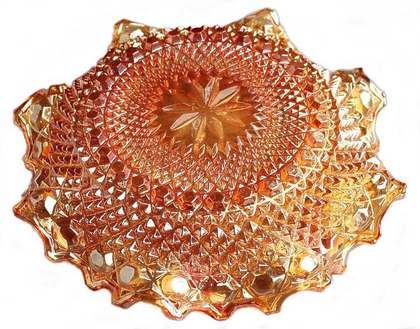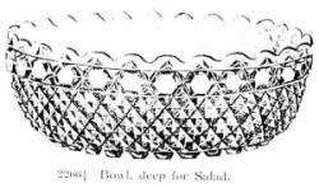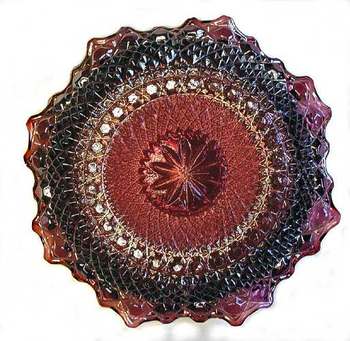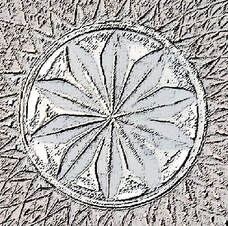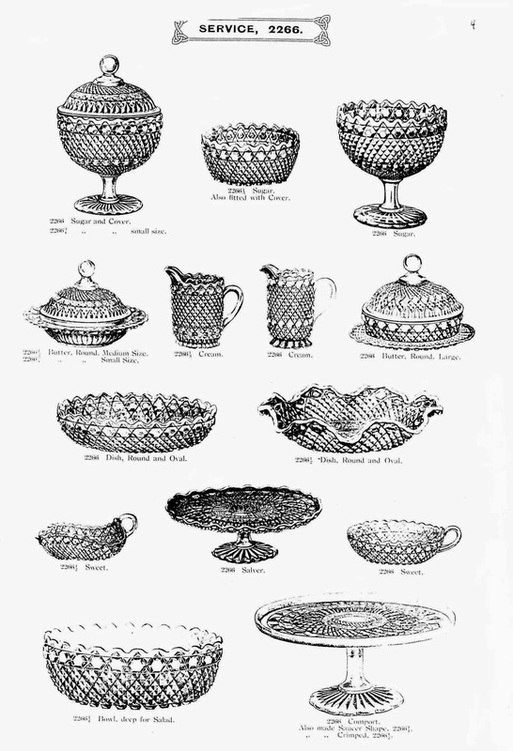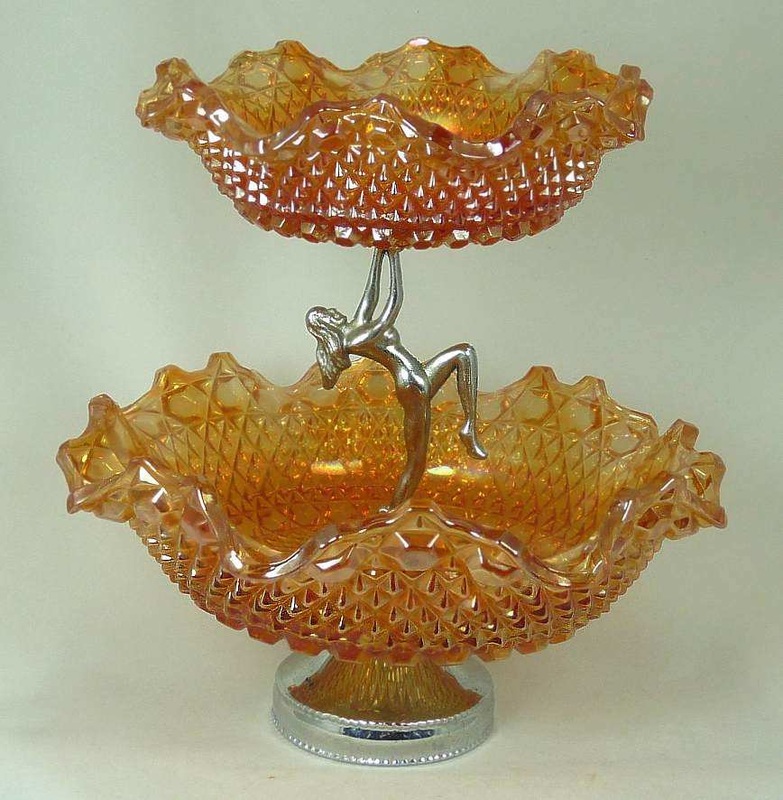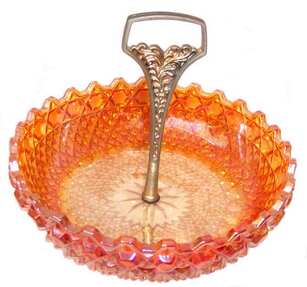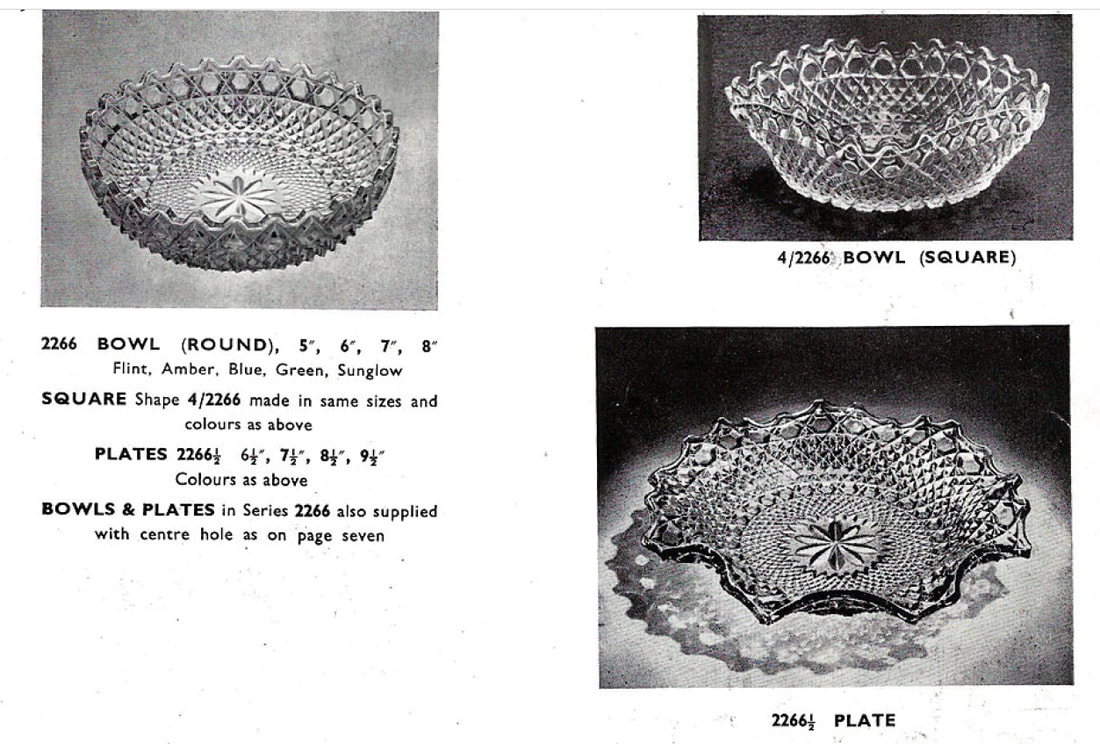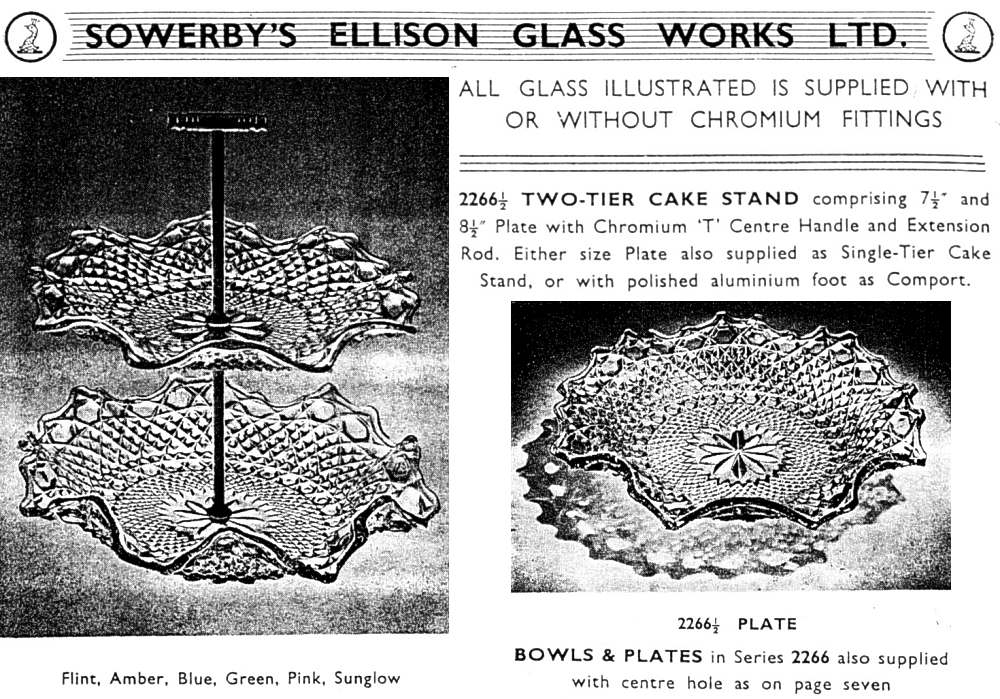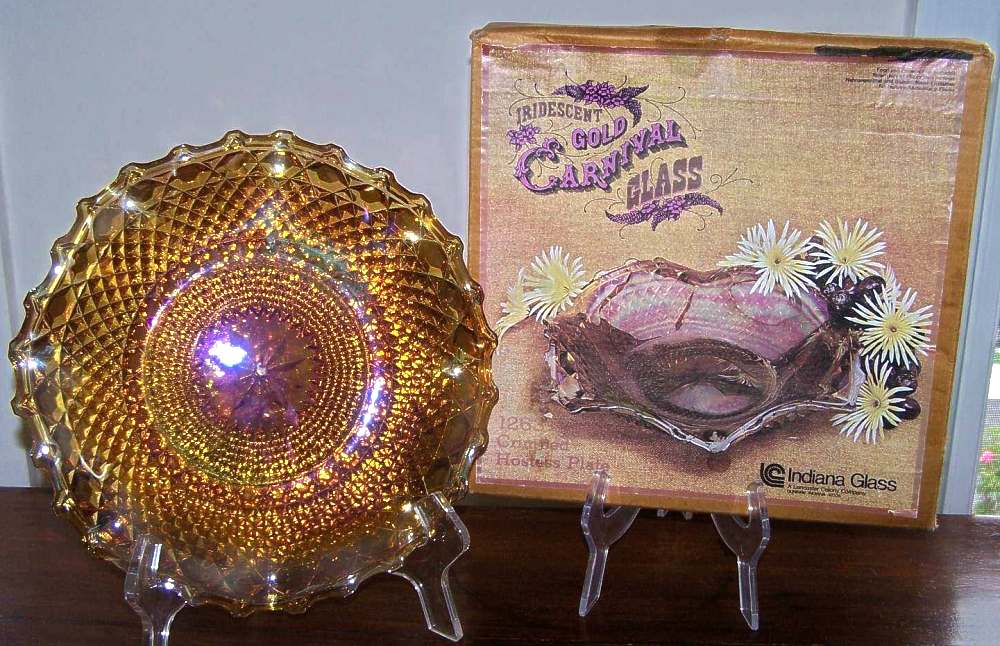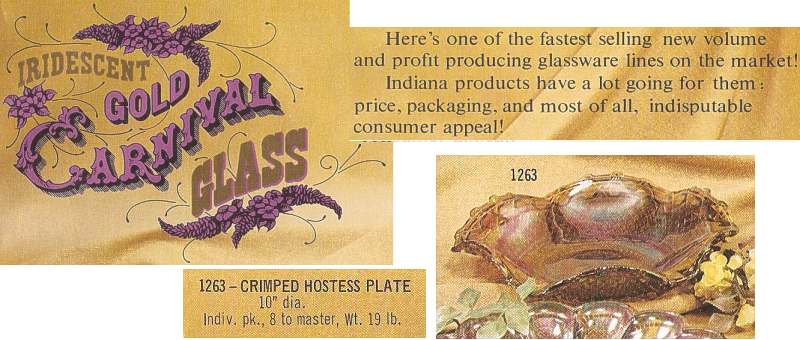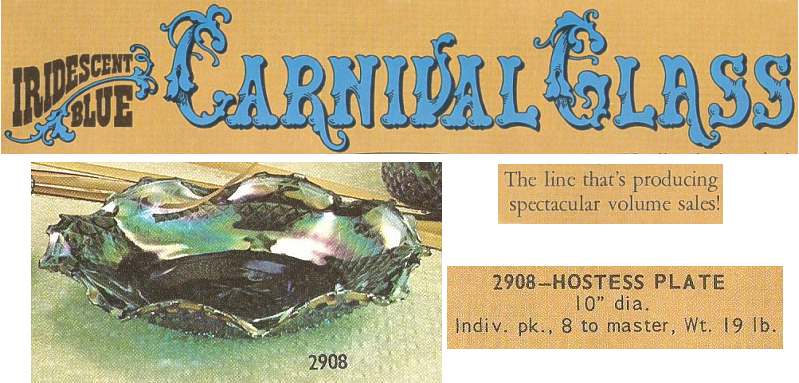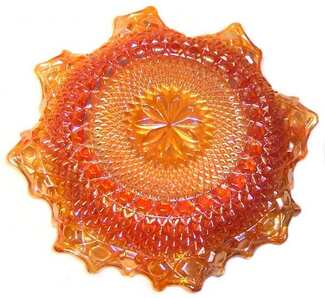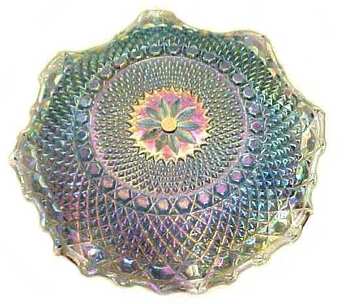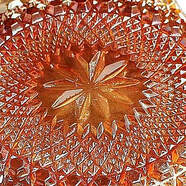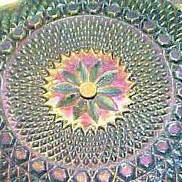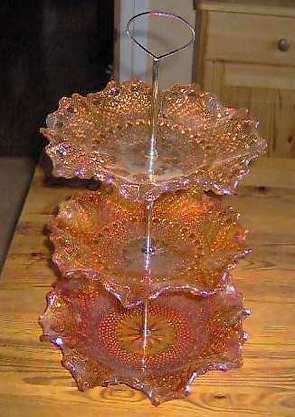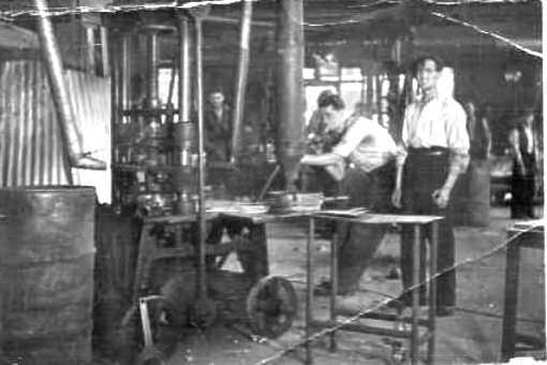Collectors Facts - Chunky, aka Service #2266, aka English Hob and Button, Sowerby
G&S Thistlewood, October 2016. Updated 2022 and 2024.
|
Shapes:
Bowls, large, 8 to 10 inches*
Bowls, small, 6 to 7 inches*
"Float" bowl, unruffled
Mounted in metalwork**
|
Colours:
Marigold, cobalt blue (rare), amethyst (rare).
Marigold
Black amethyst, one reported
Marigold
|
|
Notes:
* bowls are found in various shapes: ruffled, round, square and 6-sided. ** with added metalwork: handled servers, cake stands, two-tier and three-tier epergnes. Marigold predominates. Rarely found are blue and amethyst pieces. Uniridised flint glass examples are also known in clear/crystal, green, amber and blue. Sowerby’s Chunky (aka Service 2266, aka English Hob and Button) is a simple, geometric exterior pattern. It was introduced in 1907 and it was made (on and off) right through to the 1960s. A wide range of tableware items was illustrated in this pattern in the company’s catalogues in 1907 and 1912, showing that it was a well established pattern suite in Sowerby’s production line. During the mid 1920s, when Carnival Glass came on the scene, the pattern was produced in Carnival Glass, mainly in marigold but also in seldom seen examples of amethyst, blue and black amethyst. In the 1950s, driven by requests from a Norwegian buyer, Sowerby’s 2266 was re-introduced. Adam Dodds told us the full fascinating story of its reintroduction - scroll down the page for Adam's humorous account! |
Above: a Chunky bowl in amethyst.
|
|
In 2022, a cobalt blue bowl with a marie (collar base, which was probably ground) encircling the central 10-point star was shown in our Carnival NetworK Facebook group. Recently, a second cobalt blue bowl with the same distinctive collar base was seen on the internet, confirming the earlier report from 2022. Both bowls had deep blue base glass, like that seen on Sowerby’s Flora bowls and the Covered Swan and Hen butters. We believe they were made sometime after Sowerby’s early Carnival production, although the precise timing is as yet uncertain. The iridescence on these cobalt blue bowls is Sowerby’s typical “Rainbo” – a deep, purple-blue effect. We believe these cobalt blue Chunky bowls with the collar base are Sowerby items. Glen's sketch of the encircling collar base on the cobalt blue bowl is shown here on the right. |
Above: sketch of a Chunky bowl with a marie.
|
It’s interesting to note that the pattern was made in a range of bowls and plates that are sometimes fitted with a variety of unusual metal stands as shown above. Two- and three-tier items are known with the stands frequently formed as female figures. Sowerby’s catalogue Number 37 (dating from 1954) states that the bowls were available in “Sunglow Iridescent shade …..with or without chromium fittings.
Shown below are two Sowerby catalogue extracts from 1956. They show Chunky / 2266 items being made in "Sunglow" (marigold Carnival) as well are non-iridised flint (clear) glass, amber, blue, green and pink. Note how the ad on the right offers the bowls predrilled with a centre hole for chromium (most likely EPNS - Electro Plated Nickel Silver) fittings which themselves were an optional extra.
It’s interesting to note that the pattern was made in a range of bowls and plates that are sometimes fitted with a variety of unusual metal stands as shown above. Two- and three-tier items are known with the stands frequently formed as female figures. Sowerby’s catalogue Number 37 (dating from 1954) states that the bowls were available in “Sunglow Iridescent shade …..with or without chromium fittings.
Shown below are two Sowerby catalogue extracts from 1956. They show Chunky / 2266 items being made in "Sunglow" (marigold Carnival) as well are non-iridised flint (clear) glass, amber, blue, green and pink. Note how the ad on the right offers the bowls predrilled with a centre hole for chromium (most likely EPNS - Electro Plated Nickel Silver) fittings which themselves were an optional extra.
|
The Indiana Copy - the "Hostess" pattern
In the 1970s, Indiana Glass (Dunkirk, IN, USA) produced a version of Sowerby’s Chunky, which they called Hostess. It is often mistaken for the original Sowerby version (and vice versa). On the right: extracts from a 1970s Indiana catalogue showing their 10 inch crimped Hostess plate in blue and in "gold" Carnival (gold being a dark, amberish marigold colour). As the catalogue indicates, the Hostess pattern was produced and sold in very large quantities! Below: a gold Hostess plate, sold in a presentation box. |
There are some easy ways to spot the difference between Sowerby's Chunky and Indiana's Heirloom patterns..
Colour is one helpful indicator. Sowerby originals were made in marigold (on clear glass) and some very rare examples of amethyst, cobalt blue and black amethyst. The Indiana Carnival examples are found in gold, blue and lime green for the larger sized (up to 10 inch) bowl, and in blue for the rare small size bowl (6.5 inches).
The iridescence on the Indiana pieces is vivid and very distinctive.
There are also small differences in the pattern details. An easy difference to spot is the central button in the middle of the star base on the Indiana pieces. There is no button on the Sowerby pieces, and the points of the star meet in the centre. Also, there is more blank space around the central (marie) star on the Indiana version - the Sowerby star almost runs into the band of small diamonds. Additionally, the central band of small diamonds is separated from the large hobnails by a gap on the Indiana copies, while on the Sowerby version, the small diamonds run into the large hobnails.
Interested in reading more about Sowerby's and Indiana's Carnival Glass?
We have lots more information about the Carnival production from these two companies elsewhere on our website, including several some fascinating – and unusual catalogue images. They are all linked from the individual company's Homepages, as below.
Sowerby Homepage
Indiana Glass Homepage
A Look at Sowerby’s Reintroduction of Carnival Glass in the 1950s, with a special look at the use of the old 2266 pattern
By Adam Dodds (ex-Sowerby glass technologist), as told on our Sowerby ebook (Volume 2)
"At some point Andy Wemyss (the Works Manager) and I were told that we were going to start making this fearsome stuff for the first time since WWII. It was called “Sunglow” - I had never heard of the name “Carnival” until recently. Any spraying equipment had long vanished so we raided the scrap yard next door and built our own. Someone produced the pre-war recipe for the witches' brew, which I made up and off we went.
A Look at Sowerby’s Reintroduction of Carnival Glass in the 1950s, with a special look at the use of the old 2266 pattern
By Adam Dodds (ex-Sowerby glass technologist), as told on our Sowerby ebook (Volume 2)
"At some point Andy Wemyss (the Works Manager) and I were told that we were going to start making this fearsome stuff for the first time since WWII. It was called “Sunglow” - I had never heard of the name “Carnival” until recently. Any spraying equipment had long vanished so we raided the scrap yard next door and built our own. Someone produced the pre-war recipe for the witches' brew, which I made up and off we went.
|
I cannot recall spraying Sunglow on anything else but flint and 95% of production must have been 2266 (aka Chunky aka English Hob & Button) in all its sizes and shapes. We never tried any other sprays, discounting playing with commercial sample sprays which had to be fired on and the results certainly never left the factory. We only tried them because the samples were free! Usual disclaimer - I don't know what happened after I left. At the risk of being cynical I don't think Sowerby’s would have recognised a marketing strategy if one bit them!! We sold anything to anyone. Export orders depended entirely on who the agent was in the areas concerned and how good they were. No Sowerby’s staff went abroad (apart from my grandfather in c. 1919, but that wasn't marketing) but then very few people did at the time. By far our best agent was the Norwegian one and he took an incredible amount of 2266. I think the Norwegian agent was in part at least responsible for the re-introduction of 2266. Sadly, I cannot remember whether that included Sunglow, but I rather think not. |
Sowerby catalogue #38, 1956. Their 2299 was supplied with or without
a drilled centre hole and chrome fittings. |
|
I'm probably repeating myself here, but the only strategy that occurs to me re Sunglow concerned the colour variation. What came out of the lehr varied from almost flint to almost black. The extreme ends were scrapped, the "middle cut" as it were went to normal customers and the "near misses" at either end were stored until early June each year when the showmen arrived for the huge fair (Carnival?) on Newcastle Town Moor. They took the lot at silly prices. To the best of my knowledge these were the only "seconds" of any sort which Sowerby’s sold.
2266 was a tremendously successful pattern when it was reincarnated during my time. Astonishing to those of us who couldn't believe that it was making a comeback. There were three or four sizes, three shapes, five colours (including Sunglow - Carnival), drilled (for the metal holders and stands) and undrilled. A frightening stock control problem. However, it was a doddle to make, the pattern covering up a multitude of sins. The total numbers made must have been in the high hundreds of thousands. Some of us, including me, thought it hilarious at the idea that anyone might buy anything as hideous as 2266. How wrong we were! Mind you, my own views haven't changed much aesthetically, but it was a wonderful pattern for hiding faults! I have no idea what happened to any old moulds but a lot must have been lost due to neglect and bad storage resulting in rust." |
See more Collectors Facts
